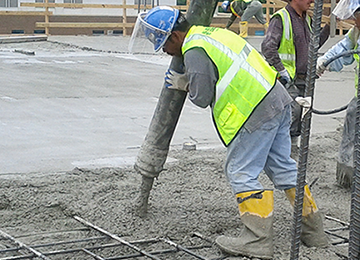Northwestern Mutual Tower and Commons, Milwaukee, WI
9200 CY Mat Slab Pour for 32-story Office Building, March, 2015
As you might imagine a lot of planning goes into the construction of a 32-story office building. The first part of any building is the construction of the concrete foundation. For this project, the building will be supported on a 10-foot thick concrete mat slab constructed in one continuous pour. The placement of 9200 cubic yards of concrete is a challenge for even the largest general contractors.
One critical element of the placement of a large volume of concrete is to control the temperature of the concrete mass as it cures. When concrete cures, the reaction of Portland cement with water in the mix gives off heat, called heat of hydration. If the temperature of concrete exceeds 158oF, the concrete can expand and crack, which might not be evident for years. In addition, temperature differences of 35oF or more between the middle of the concrete and the surface can result in thermal cracking, and concrete surfaces should not be exposed to cooling of more than 20oF per day. Given that the concrete placement would take place at the end of March, the temperature in the middle of the 10-foot thick slab could be much higher than freezing conditions at the surface.
The General Contractor, C.G. Schmidt, recognized the need to evaluate the amount of heat that would be generated from such a large mass of concrete. ECS was asked by C.G. Schmidt to evaluate the amount of heat that might be generated and how to monitor and control it if necessary. They knew that our Milwaukee office senior professional staff has expertise in heat of hydration issues and concrete instrumentation.
Two months prior to the big placement, ECS instrumented two 4-foot cubes of concrete, each with a different concrete mix. Temperature data was recorded over a period of weeks. ECS found that there was a 70oF heat gain while curing. In addition, ECS made 24 concrete cylinders for each cube and developed a maturity curve for each concrete mix. We provided our maturity curves and compressive strength data to the structural engineer, Simpson Gumpertz & Heger, Inc. (SGH, Boston, MA) so they could analyze and extrapolate the heat gain in the proposed 10-foot thick slab. SGH decided that the heat gain would pose too much of a risk and recommended that a large network of PVC tubes be installed within the mat. The tubes would be filled with circulating cool water to draw excess heat from the concrete mass during the early stages of curing.
Prior to concrete placement, ECS attached 22 probes to the reinforcing steel at various locations and depths. These probes were used to monitor the temperatures during the entire 29-hour concrete placement, then 1-3 times per day after the pour. The temperature monitoring and cool water circulation tubes facilitated control of temperatures during curing and the successful construction of the mat slab.
For more information about heat of hydration in mass concrete, contact Charles S. Gresser, P.E. in our Milwaukee office.

